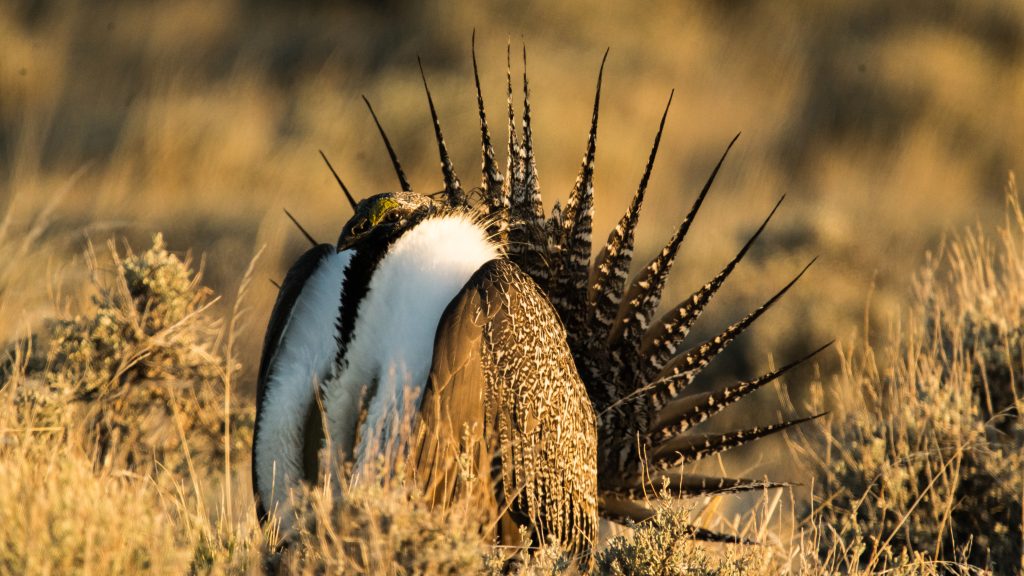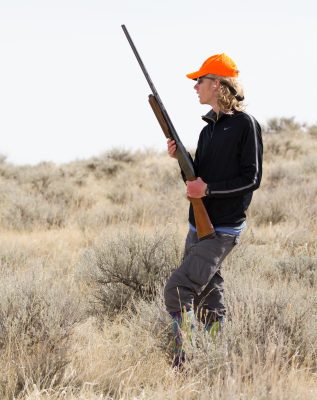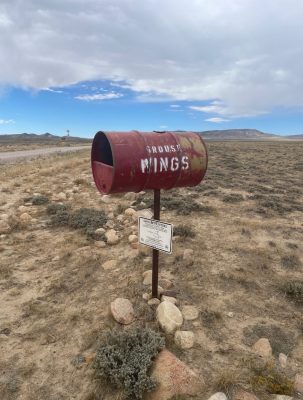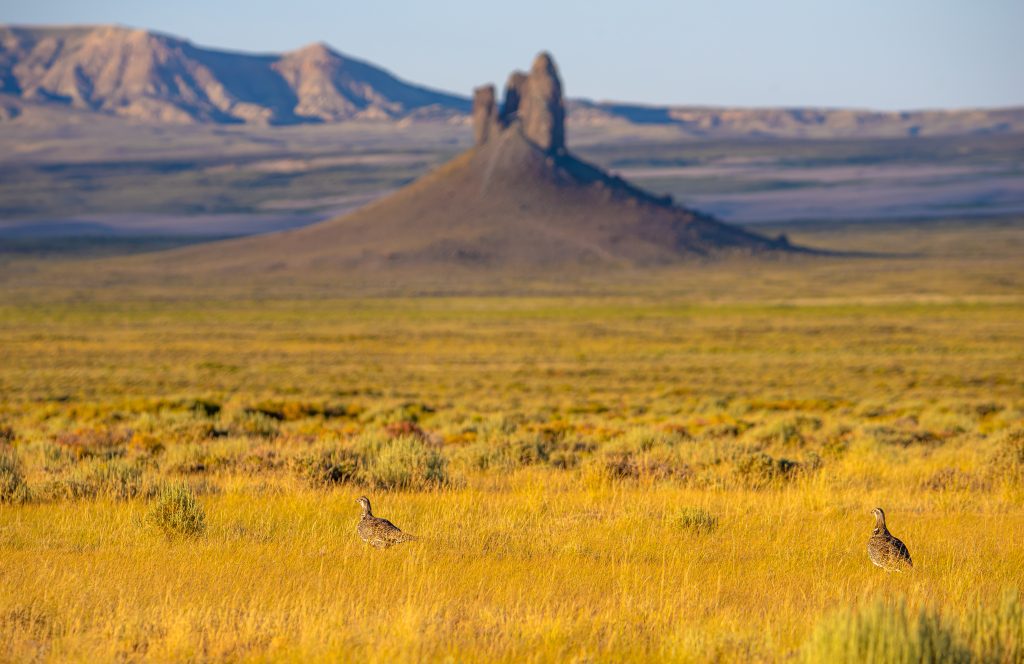The answer may be surprising.

To hunt, or not to hunt? When it comes to a declining species like the greater sage‐grouse, the answer may appear obvious, especially from a conservationist perspective. But what do the numbers say?
The question took Jeff Beck all the way back to the 1870s in a series of unique, range‐wide studies that analyzed hunting season regulations and other factors impacting sage‐grouse populations.
Beck, a professor in UW’s Department of Ecosystem Science and Management, is a scientist, hunter, and sage‐grouse expert. “They fascinate me like nothing else,” he says. “They live in these really tough landscapes, and they do quite well if we conserve good habitat. They’re an indicator of the health of the sagebrush ecosystem, so we want to understand what’s driving population trends and what we can do to help increase populations.”
Sage‐grouse populations tend to oscillate over time in response to seasonal weather, but have been slowly declining for decades. They are extremely sensitive to surface disturbance caused by human activity (such as oil and gas infrastructure), precipitation, wildfire, and other environmental factors.
Previous studies have shown that ongoing loss and degradation of sagebrush habitat presents the greatest threat to sage‐grouse populations. The impact of sport hunting is less clear.
How have hunting regulations changed over the past 150 years?
State and provincial management agencies are tasked with balancing two competing interests: maintaining viable wildlife populations and providing hunting opportunities for the public.
Using data from the 1870s–2019, Beck and former UW postdoc Jonathan Dinkins1 compiled data tracking changes in harvest management in 11 western states and two Canadian provinces. Early regulations were minimal, but in the 1930s and 1940s many wildlife agencies drastically reduced hunting seasons in response to declining populations. The trend has continued, with increasingly conservative approaches favored.
Common strategies included reducing bag limits, possession limits, and season lengths as well as setting later opening dates and changing permit types. When populations showed signs of decline, agencies typically responded by tightening hunting restrictions, in some cases eliminating all hunting exposure through seasonal or permanent closures.

However, “disentangling the effects of hunting closure on population growth from expected growth, especially in low populations, is challenging,” the researchers concluded. Even when hunting closures were implemented, small populations of the Gunnison sage‐grouse in Colorado and Utah did not experience growth. Similar results were observed in small populations of greater sage‐grouse in Alberta, Canada, and the western U.S.
In general, reductions continue to be more widespread than closures. Maintaining hunting seasons, albeit with restrictions, has allowed agencies to fund conservation efforts through hunting permits while limiting harvest to less than 5 or 10 percent of the fall population. Data collected from hunters also helps wildlife managers make more informed conservation decisions.
While further study is needed to assess the impacts of hunting closures, the researchers advise against using the total area of closed land as a measure of effective management. A total closed area may appear deceptively large if areas most important to sage‐grouse populations (within 8 kilometers of a lek) don’t fall completely within the closure.
Are hunting regulations effective?
In a second paper, Beck and Dinkins investigated how population trends in specific leks did—or did not—correlate to changes in human activities and environmental factors. Using lek counts provided by state and provincial agencies, the researchers analyzed population trends from 1995–2013 relative to hunting exposure, energy development, wildfire, precipitation, and the percentage of land covered by crops and trees.
The study examined 20 small sage‐grouse populations and one relatively large sage‐grouse population located in nine western states and two Canadian provinces. As predicted, not all populations were influenced by the same factors. Overall, impacts related to human activity, habitat changes, wildfires, and precipitation yielded similar results to previous studies.

The researchers found mixed results regarding the effects of hunting season regulations on sage‐grouse populations. Data suggested that discontinuing hunting in the largest population, where hunting levels were experimentally manipulated, resulted in greater population growth rates. However, for smaller populations, this was not necessarily the case.
“Probably because of the great effort by states that manage sage‐grouse to lower the impact of hunting, we don’t see hunting showing up in most places as an impact on populations,” Beck says. “Our research seems to show that really low hunting levels are probably compatible, as long as populations don’t get too low.”
In some cases, sage‐grouse populations continued to decline years after hunting was discontinued, suggesting that hunting was not the primary cause for decline. “It could be a contributing factor, especially at low population levels, but states won’t let hunting occur when populations get that low. Science says that hunting is probably okay as long as we’re really careful,” Beck concludes.
Still, hunting remains a potential contributing factor to population decline, he cautions. Scientists and managers must continue to monitor and analyze the effects of hunting and hunters must recognize that there’s a level at which populations can no longer tolerate harvest.
What’s next?
Using data sets compiled during these initial studies,2 Beck plans to investigate how implementing later hunting season start dates influences population ratios of males to juveniles and females.
In some states, including Wyoming, sage‐grouse season now opens later in the fall, a practice intended to lessen the potential impacts of hunting. Earlier in the hunting season, females and juveniles tend to be easier to find and more vulnerable than males and older birds.
Beck predicts that earlier hunting seasons are likely biased toward the harvest of younger birds. Understanding the relationship between season start dates and population ratios would allow managers to adjust season timing to optimize population viability and continue providing hunting opportunities to the public.
Beck also intends to examine the effectiveness of different reporting systems, with the ultimate goal of providing recommendations for improvement. “If you’re going to keep on hunting sage‐grouse, you have to have a better system for reporting the estimated harvest,” he notes.
With careful reporting, rigorous monitoring, and science‐based evaluation of management strategies, hunting may not be incompatible with the preservation of a declining species.
To learn more, contact Beck at jlbeck@uwyo.edu or (307) 766‐6683.
For more information
See below for links to the full text of the sage‐grouse studies referenced in this article.
Changes in hunting season regulations (1870s–2019): https://bit.ly/sg‐hunting‐regulation
Influence of environmental change, harvest exposure, & human disturbance: https://bit.ly/sg‐population‐trends





